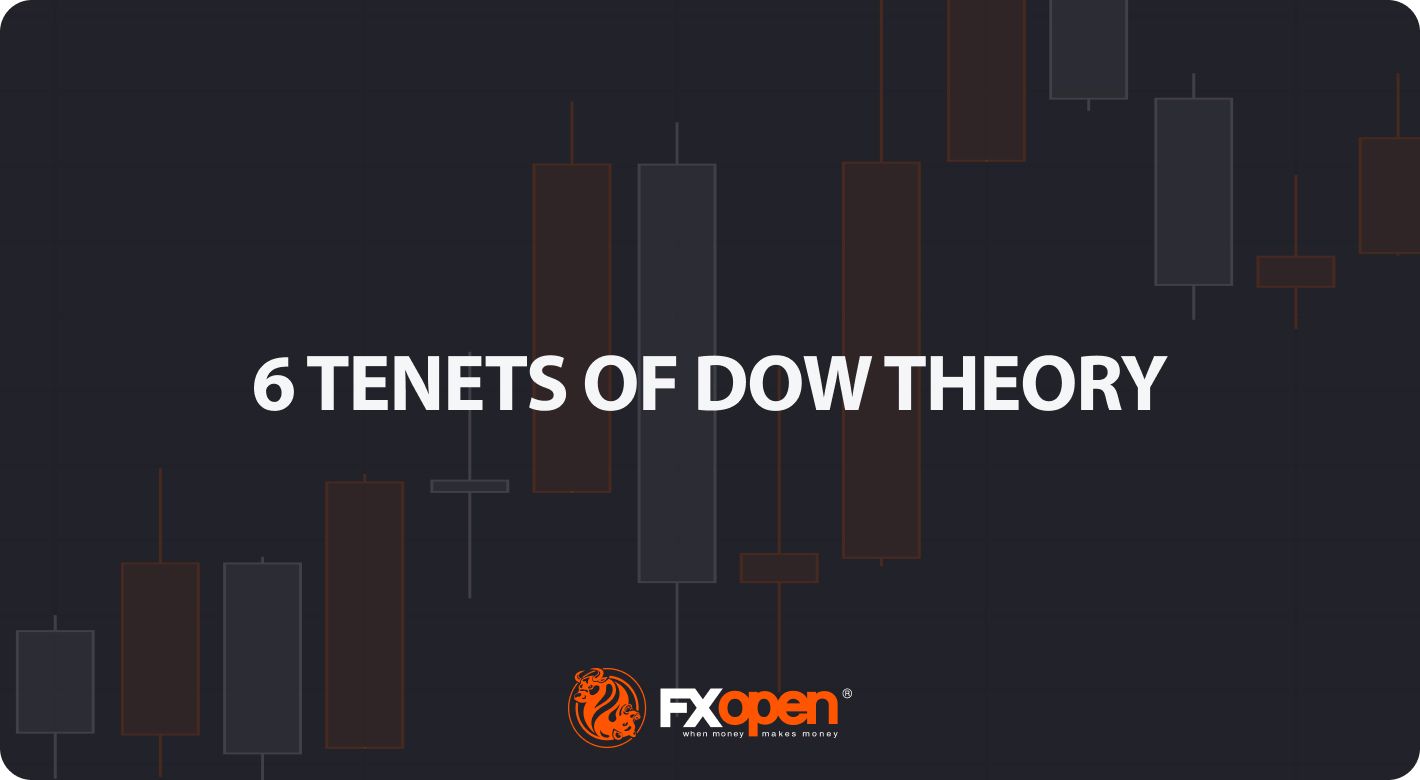FXOpen

The principles of Dow Theory relate to financial methodology named after Charles Dow, co-founder of Dow Jones & Company. It is considered one of the oldest and most iconic technical analysis methods used to predict market trends.
While originally developed to analyse stock market trends, the Dow Theory can also be applied in other markets to help traders identify and confirm trends easily.
Before we go any further, let us examine in detail the usefulness of the Dow Theory and how applicable it is.
Understanding Dow Theory in Technical Analysis
Although the Dow Jones theory of technical analysis was originally meant to address the stock market, now, it applies to different markets. To understand how you can apply this theory, we have outlined some practical ways that traders use it.
Trend Confirmation
Trend analysis trading is one of the major use cases of the Dow Theory, as its primary focus is trend confirmation. This is of high value to swing and trend traders, who often need to validate trend patterns before making a decision. By analysing multiple timeframes and looking for consistent trends, traders can gain confidence in the strength and direction of an asset’s price.
Long-Term Trend Analysis
The Dow Theory emphasises primary trends that typically last for extended periods (months to years). By identifying and following the primary trends, traders can capture larger moves and avoid getting caught in short-term fluctuations.
Volume Confirmation
Volume serves as a crucial confirmation tool in technical analysis. It involves examining trading volume alongside price movements to gain valuable insights into market trends. In the context of an uptrend, it's essential to observe that as prices rise, volume should also increase, providing validation of the trend's strength. Conversely, when an uptrend is accompanied by falling volume or a downtrend coincides with rising volume, these conditions can act as early warning signals of a potential trend reversal.
Reversal Signals
In the search for reversal signals, Dow Theory itself does not offer precise indications. Instead, it prompts traders to seek out various technical indicators, chart patterns, or other discernible signs that may signify an impending shift in the primary trend. Some widely recognised reversal signals encompass the breach of trendlines, the emergence of head and shoulders patterns, as well as distinctive candlestick patterns. These tools play a pivotal role in recognising potential market reversals and guiding trading decisions effectively.
It is important to note that each market has its unique characteristics, which may require additional considerations beyond the Dow Theory. Traders often combine the principles of the Dow Theory with other technical analysis tools, indicators, and fundamental analysis to develop a comprehensive trading strategy.
6 Tenets of Dow Technical Analysis Theory
The Dow Theory is based on six main tenets that guide traders in understanding and predicting market trends. These tenets are as follows:
1. The Market Discounts Everything
According to the Dow Theory, the stock market reflects all available information, including economic data, corporate earnings, news events, and investor sentiment. Market prices incorporate all known factors that could influence supply and demand for a particular asset. For example, if a company releases better-than-expected earnings, this information is quickly reflected in the stock price as buyers step in and bid higher prices.
2. The Market Moves in Trends
The second tenet of the Dow Theory states that the market moves in three primary trends:
- Long-term primary
- Intermediate secondary
- Short-term minor
These contribute individually to help traders identify the market's overall direction and make better trading decisions. For instance, if the primary trend is bullish, traders will look for opportunities to buy during pullbacks in the secondary or minor trend.
3. The Primary Trend Has Three Phases
The primary trend consists of three phases: the accumulation phase, the public participation phase, and the distribution phase. The accumulation phase occurs when smart money (institutional investors or experienced traders) buy an asset at low prices. The public participation phase occurs when the general public recognises the upward movement and starts buying. Finally, the distribution phase occurs when investors sell their positions to the public as prices peak and a price reversal begins. By recognising these phases, traders can determine the most suitable strategy.
4. Averages Must Confirm Each Other
The Dow Theory emphasises confirming indices, specifically the Dow Jones Industrial Average (DJIA) and the Dow Jones Transportation Average (DJTA). When analysing a trend, traders look for both indices to move in the same direction to confirm the strength. For example, if the DJIA is making new highs while the DJTA fails to do so, it could be an early warning sign of a weakening bull market.
5. Volume Should Confirm Trend
Volume is an essential aspect of the Dow Theory. Trading volume should increase as a trend progresses, confirming the strength of the trend. For example, during a bullish trend, as prices rise, trading volume should increase, indicating that buyers are actively participating. Conversely, a lack of volume during a price move suggests a lack of conviction and may indicate a weakening momentum.
6. Trends Persist Until Reversal
The Dow Theory assumes that trends will continue until sufficient evidence suggests a reversal. Traders should avoid assuming a change in the price direction until it is confirmed by price movement and volume. For instance, if a stock has been in a long-term uptrend and experiences a short-term pullback, traders would not consider it a reversal unless there are clear signs of a change in the price, such as sustained price declines accompanied by high volume.
You can practise Dow principles and other strategies on FXOpen's TickTrader platform.
Final Words
It's important to note that the Dow Theory, like any other technical analysis tool, is not foolproof and might be used with other indicators and risk management strategies. Regular monitoring and adjustment are necessary to adapt to changing market conditions. Open an FXOpen account today and enjoy unlimited trading opportunities!
This article represents the opinion of the Companies operating under the FXOpen brand only. It is not to be construed as an offer, solicitation, or recommendation with respect to products and services provided by the Companies operating under the FXOpen brand, nor is it to be considered financial advice.
Stay ahead of the market!
Subscribe now to our mailing list and receive the latest market news and insights delivered directly to your inbox.








